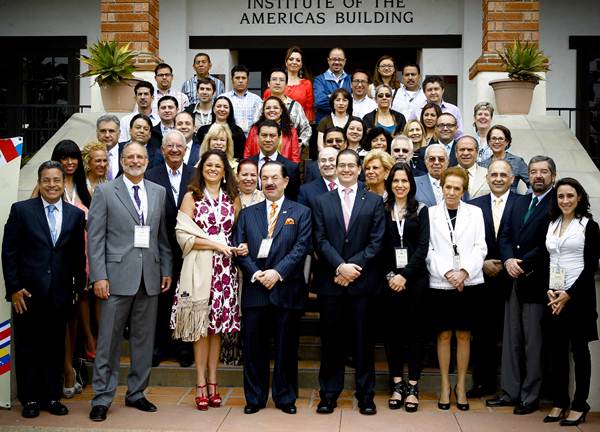Mexican-American Network Upgrade Enables Cross-Border Collaboration
San Diego, Calif. and Ensenada, Baja California, Mexico, June 30, 2012 — The networking capabilities of a major new 10 Gigabit Ethernet (GigE) link between the U.S. and Mexico were put to the test in late June during a technology demonstration at the University of California, San Diego for a group of visiting Latin American journalists.
|
At UC San Diego’s California Institute for Telecommunications and Information Technology (Calit2), two dozen reporters attending the ninth Jack F. Ealy Workshop on Scientific Journalism in San Diego, organized by UCSD’s Institute of the Americas, were able to speak directly with scientists and engineers at the Centro de Investigación Científica y de Educación Superior de Ensenada (CICESE) in Ensenada, Baja California. While the majority of the journalists were from Mexico, they also included newspaper, television, radio and online reporters and editors from Brazil, Chile, Colombia, Costa Rica, Panama and Venezuela.
The journalists were visiting Calit2 for a series of demos showcasing the institute’s advanced visualization and remote-collaboration systems, some of which have now been installed at CICESE as well.
“We have a longstanding collaboration with UCSD researchers in Calit2, but until now, having a face-to-face meeting usually required a lot of travel,” said Dr. Raúl Rivera, Director of the Telematics Division at CICESE and president of the development committee of the Corporación Universitaria para el Desarrollo de Internet (CUDI), the advanced network serving Mexico’s universities and research institutions. Rivera appeared clearly on Calit2’s Touch Wall with two colleagues, José Lozano, Head of CICESE's Computer Department, and systems engineer Jorge Zuñiga, thanks to a LifeSize High Definition videoconferencing system and the new 10 GigE optical-fiber link connecting CICESE and Calit2:
“We anticipate that new research projects will result from this new ability to see and listen to each other very clearly, as if we were sharing the same laboratory,” said Rivera.
Asked by the Latin American journalists about the types of research he expects to come out of this collaboration, Rivera mentioned specifically oceanographic and atmospheric research, as well as improved reaction to natural disasters that might affect both regions.
As seen from San Diego, Rivera was sitting in a CICESE lab with two IT engineers — Computer Department Head José Lozano and Systems Engineer Jorge Zuñiga — and, behind them, a large OptIPortal tiled display wall that they built with support from Calit2 systems and networking engineers, including Technical Director Greg Hidley and Joseph Keefe.
The reporters and correspondents at Calit2 hailed from media organizations such as Mexico’s El Universal newspaper and several TV networks including Televisa, TV Azteca and Channel 11, while many of the representatives from other Latin American countries were science journalists for newspapers and magazines (e.g., El Tiempo in Colombia, La Nación in Costa Rica, Ciência Hoje in Brasil and El Mercurio in Valparaíso, Chile).
In her dispatch to El Universal titled, ‘Calit2, una mirada al future del video’ (Calit2, a look into the future of video), environmental reporter Mariana León Medina wrote that Calit2 researchers “are using technology to communicate with academics and experts from other countries, in real time, without delays and at the highest quality and… one of the institutions they are working with is [CICESE].”
Videoconferencing is just one of the collaborative capabilities of the link between CICESE and Calit2. Both institutes specialize in highly bandwidth-reliant and data-intensive disciplines, including distributed learning and sharing of rich-media resources among students on both sides of the border, as well as the development of software tools that support network-based collaboration. Until recently, the cross-border bandwidth was at best 1 GigE – a serious impediment to Mexico-U.S. collaboration in these and other fields.
|
In late May, Calit2’s Greg Hidley demonstrated the 10GigE link at the CUDI Education and Research Networking Consortium annual meeting, which was held at CICESE last month. CUDI is responsible for research and education networking in Mexico, and the partnership is supported there by the Consejo Nacional de Ciencia y Tecnología (CONACYT), Mexico’s equivalent to the U.S. National Science Foundation.
Those in attendance also included the Mexican Space Agency (Agencia Espacial Mexicana), UNAM (National Autonomous University of Mexico) and the Mexican Agency on Oceans and Coasts (Agencia Mexicana de Mares y Costas), as well as Calit2.
The event also featured a talk by Calit2’s Hidley titled "Bringing Mexico into the Global LambdaGrid.” During the demonstration of the link’s new networking capabilities, participants saw people interacting with scientific data in real time in both locations, including on-the-fly pushes of local laptop data on the shared display walls in Mexico and the U.S. Advanced visualization of LIDAR data was also shown in a presentation anchored at CICESE.
“An underlying theme of the CUDI conference was that the new 10GigE networking connectivity between the United States and Mexico is providing a modern infrastructure for advanced scientific collaboration,” remarked Hidley. “The potential for increased U.S.-Mexican scientific collaboration became very apparent to the attendees, and CUDI plans to extend this network to other UNAM [National Autonomous University of Mexico] institutions, which will further open up opportunities for international collaboration.”
Story by Doug Ramsey, with additional reporting by Tiffany Fox
Related Links
Media Contacts
Tiffany Fox, (858) 246-0353, tfox@ucsd.edu


